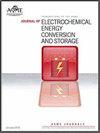CHROMIUM POISONING MITIGATION STRATEGY IN STRONTIUM DOPED LANTHANUM MANGANITE BASED AIR ELECTRODES IN SOLID OXIDE FUEL CELLS
IF 1.9
4区 工程技术
Q3 ELECTROCHEMISTRY
Journal of Electrochemical Energy Conversion and Storage
Pub Date : 2023-03-24
DOI:10.1115/1.4062192
引用次数: 0
Abstract
Chromium poisoning of the air electrode remains an obstacle to the long-term performance of solid oxide fuel cells (SOFCs). In Sr-doped LaMnO3 (LSM) air electrodes, the poisoning process results in two types of deposits, chromium oxide (Cr2O3), and Mn, Cr spinel (MnCr2O4). The former forms electrochemically and the latter forms via a chemical reaction. By applying a small anodic reverse bias, Cr2O3 deposits can be removed because their formation is electrochemical in nature. However, MnCr2O4 deposits remain because their formation is chemical, rather than electrochemical, in nature. In-situ chemical decomposition of the Mn, Cr spinel was investigated as an alternate removal method as thermodynamics supports its decomposition into constituent oxides below ~540°C in pure oxygen. The spinel decomposition process was characterized using TGA and XRD analyses. The experimentally determined rate of spinel decomposition was undetectable (very slow) with isolated MnCr2O4 powders. The addition of 10 mole% gadolinia doped ceria (GDC) and silver powders significantly increased the rate of decomposition. However, the rate is limited by the diffusion of oxygen through the decomposed oxide layer. Although one strategy may be the addition of GDC and silver to the LSM air electrode to enhance spinel decomposition, the more effective mitigation strategy would be to prevent the formation of MnCr2O4 spinel in the first place through the removal of the reactants: Cr2O3 via electrochemical cleaning and mobile Mn ions in the zirconia electrolyte by incorporating a diffusion barrier layer such as GDC between the air electrode and electrolyte.固体氧化物燃料电池中锶掺杂锰酸镧基空气电极的铬中毒缓解策略
空气电极铬中毒是影响固体氧化物燃料电池(sofc)长期性能的一大障碍。在sr掺杂LaMnO3 (LSM)空气电极中,中毒过程产生两种类型的沉积物:氧化铬(Cr2O3)和Mn, Cr尖晶石(MnCr2O4)。前者通过电化学形成,后者通过化学反应形成。通过施加一个小的阳极反向偏压,可以去除Cr2O3沉积物,因为它们的形成本质上是电化学的。然而,MnCr2O4沉积物仍然存在,因为它们的形成是化学的,而不是电化学的。研究了原位化学分解Mn, Cr尖晶石作为一种替代的去除方法,因为热力学支持其在纯氧中分解成组分氧化物,温度低于~540℃。采用TGA和XRD分析对尖晶石的分解过程进行了表征。实验测定的尖晶石分解速率在分离的MnCr2O4粉末中无法检测到(非常缓慢)。添加10摩尔%钆掺杂二氧化铈(GDC)和银粉显著提高了分解速率。然而,速率受到氧气通过分解的氧化层扩散的限制。虽然一种策略可能是在LSM空气电极中添加GDC和银来促进尖晶石的分解,但更有效的缓解策略是首先通过电化学清洗去除Cr2O3和氧化锆电解质中移动的Mn离子来防止MnCr2O4尖晶石的形成,方法是在空气电极和电解质之间加入GDC等扩散阻挡层。
本文章由计算机程序翻译,如有差异,请以英文原文为准。
求助全文
约1分钟内获得全文
求助全文
来源期刊

Journal of Electrochemical Energy Conversion and Storage
Engineering-Mechanics of Materials
CiteScore
4.90
自引率
4.00%
发文量
69
期刊介绍:
The Journal of Electrochemical Energy Conversion and Storage focuses on processes, components, devices and systems that store and convert electrical and chemical energy. This journal publishes peer-reviewed archival scholarly articles, research papers, technical briefs, review articles, perspective articles, and special volumes. Specific areas of interest include electrochemical engineering, electrocatalysis, novel materials, analysis and design of components, devices, and systems, balance of plant, novel numerical and analytical simulations, advanced materials characterization, innovative material synthesis and manufacturing methods, thermal management, reliability, durability, and damage tolerance.
 求助内容:
求助内容: 应助结果提醒方式:
应助结果提醒方式:


